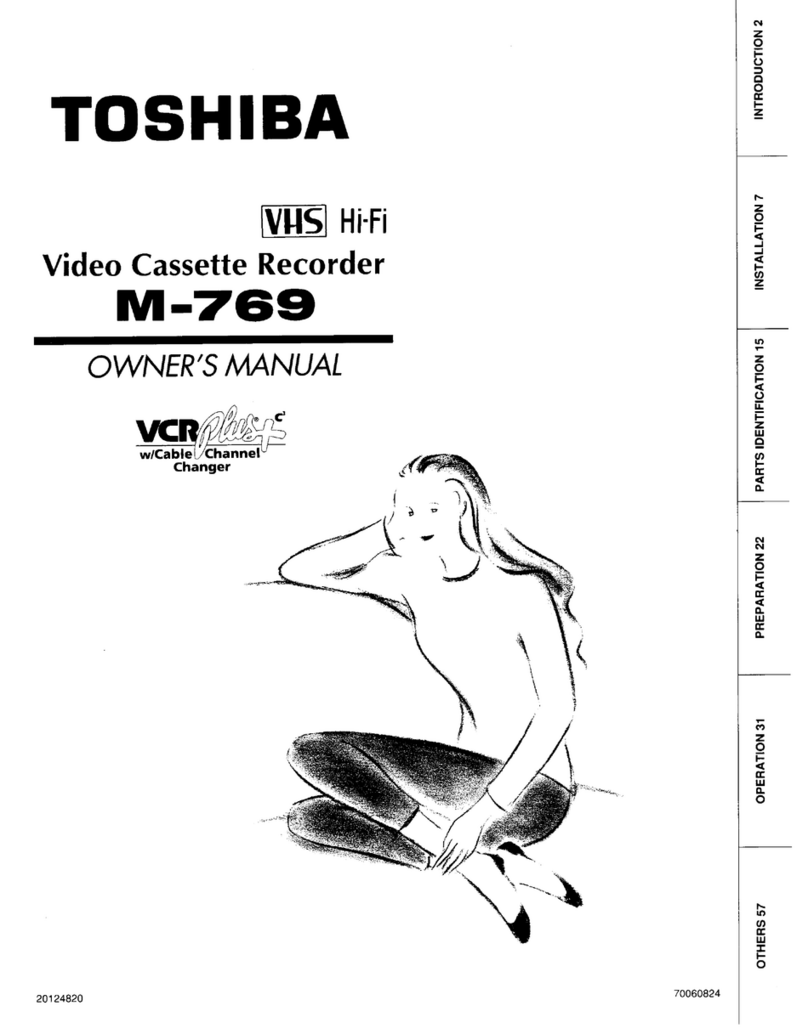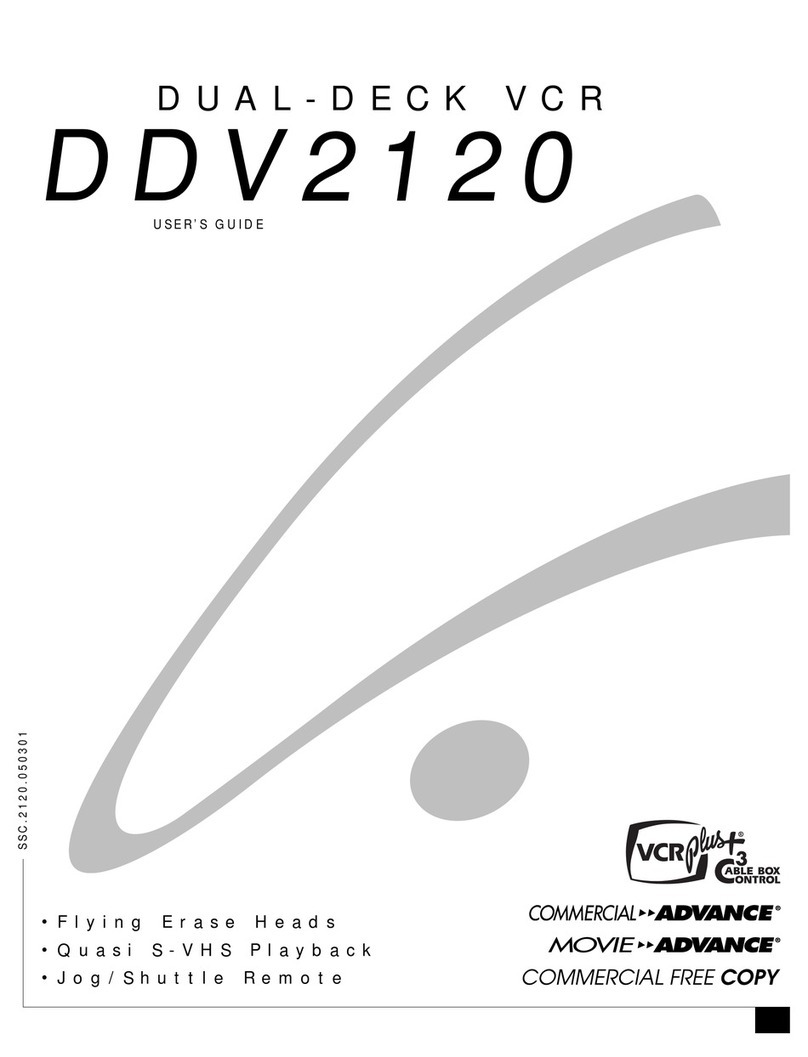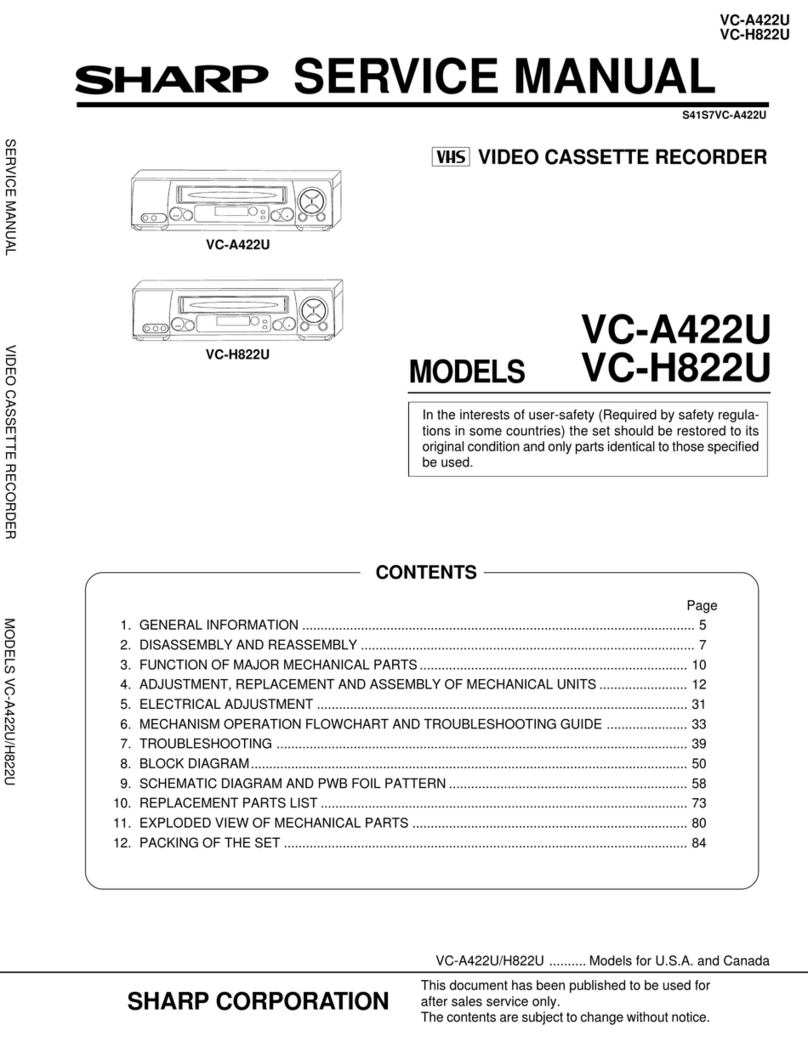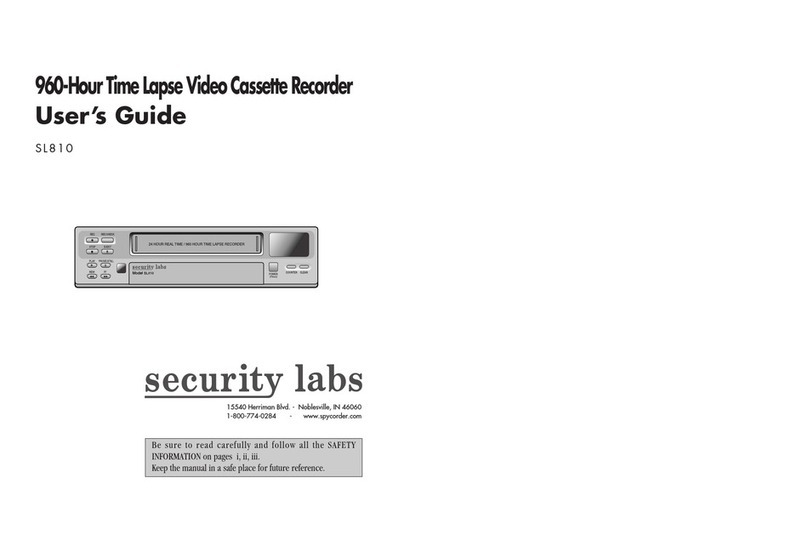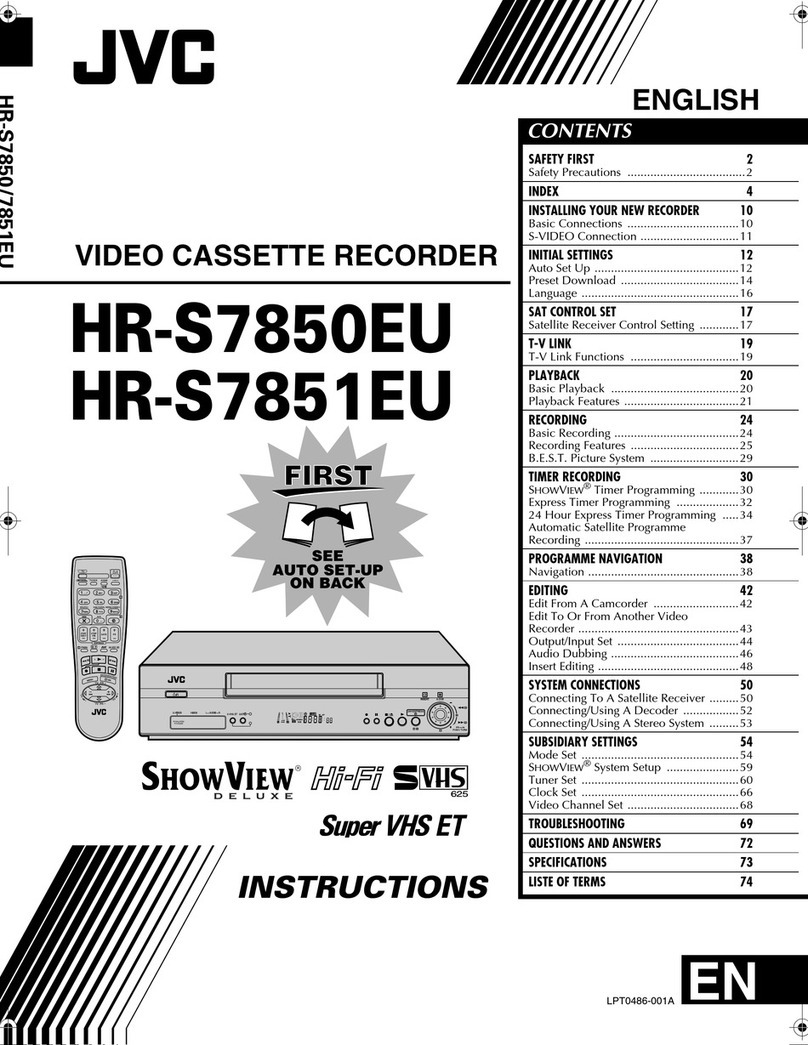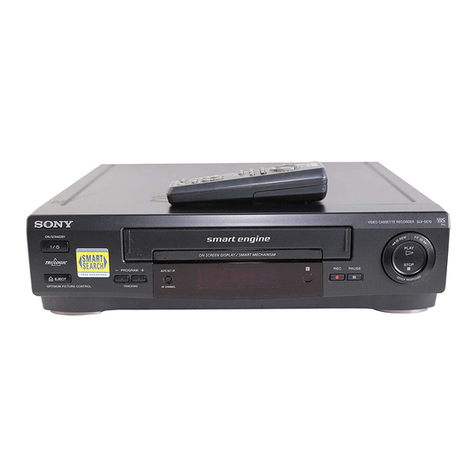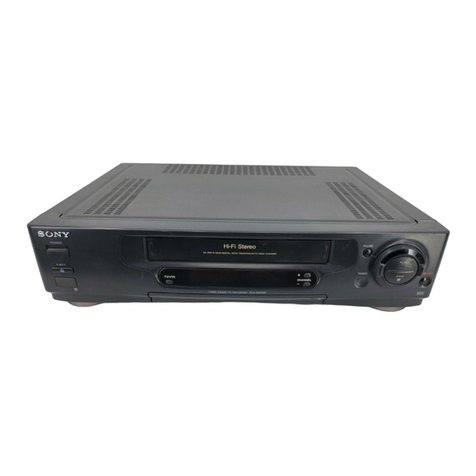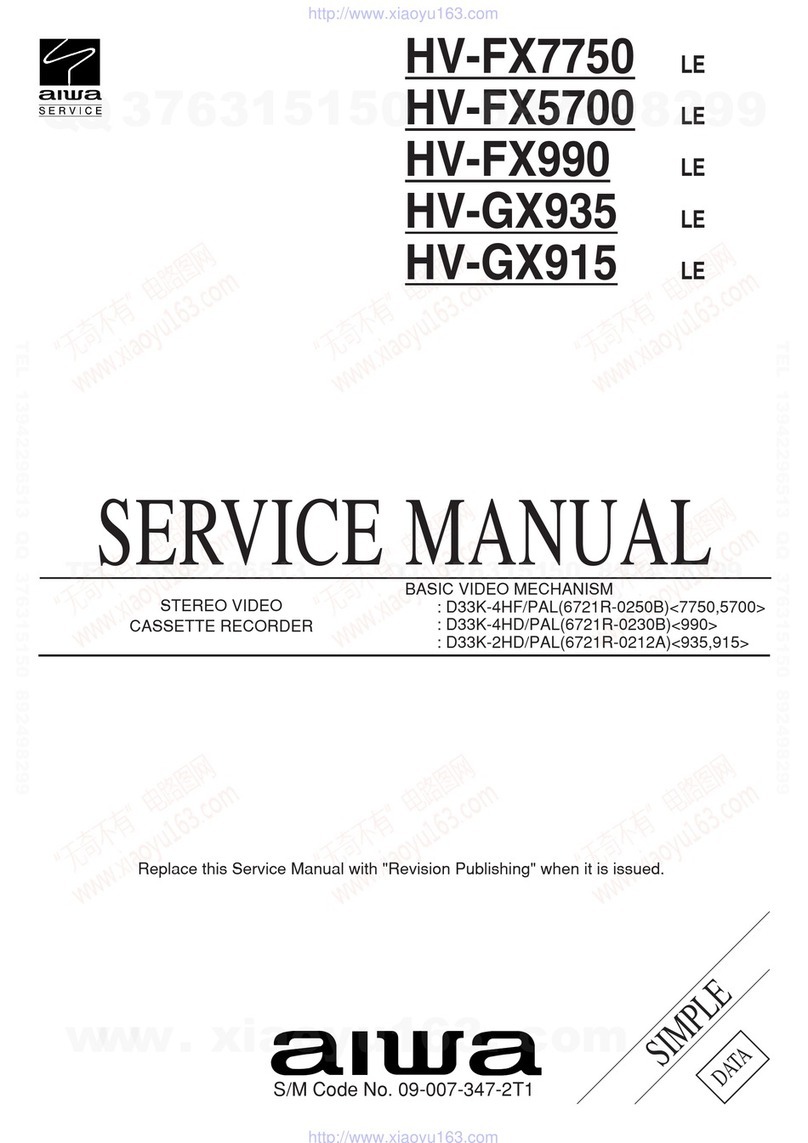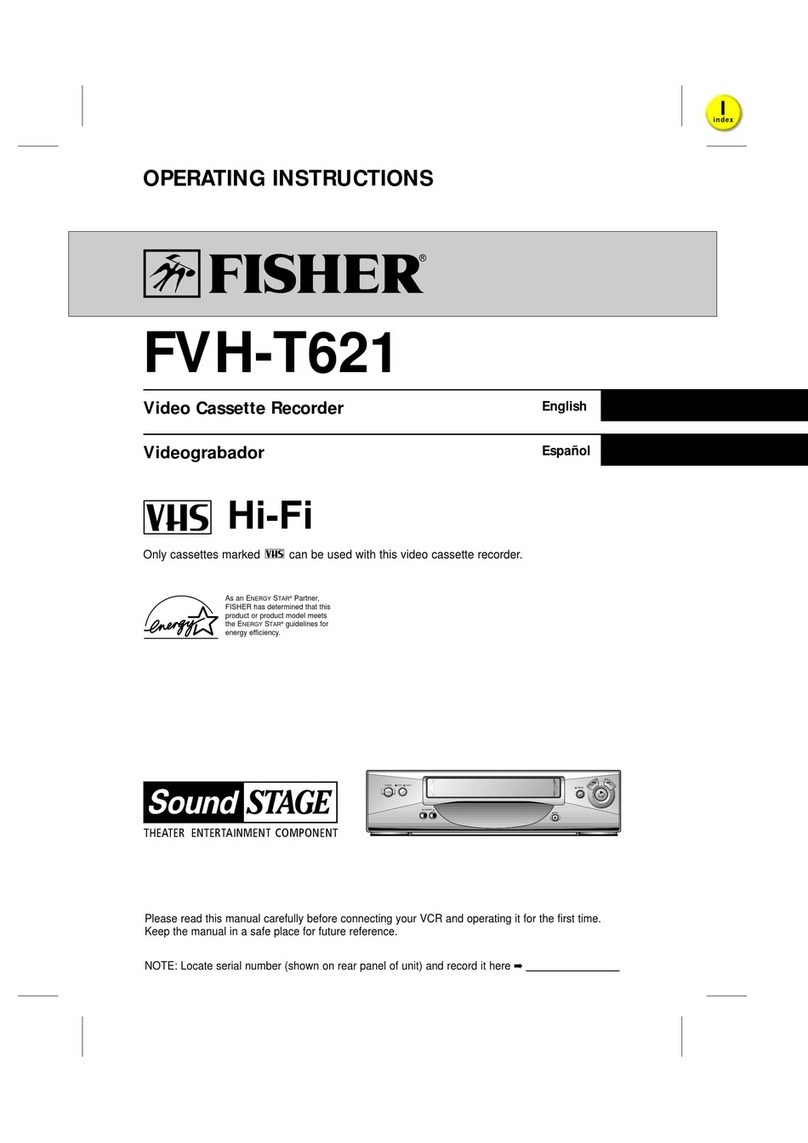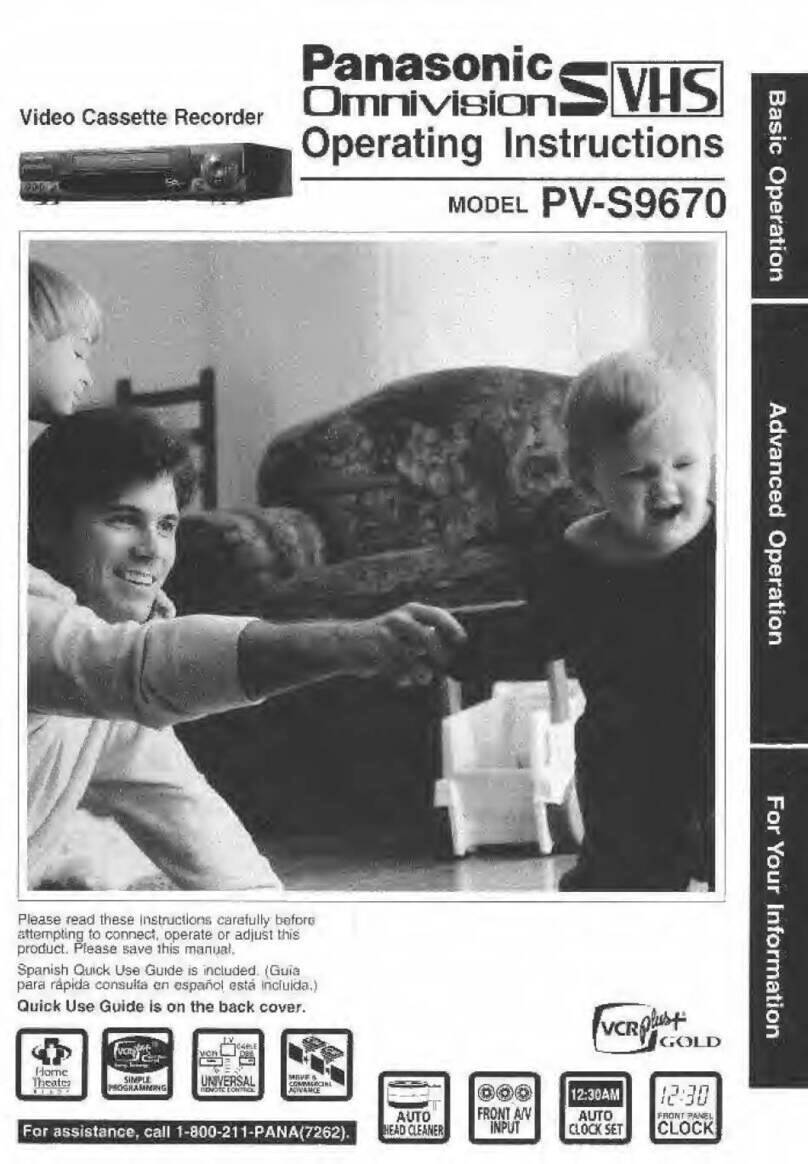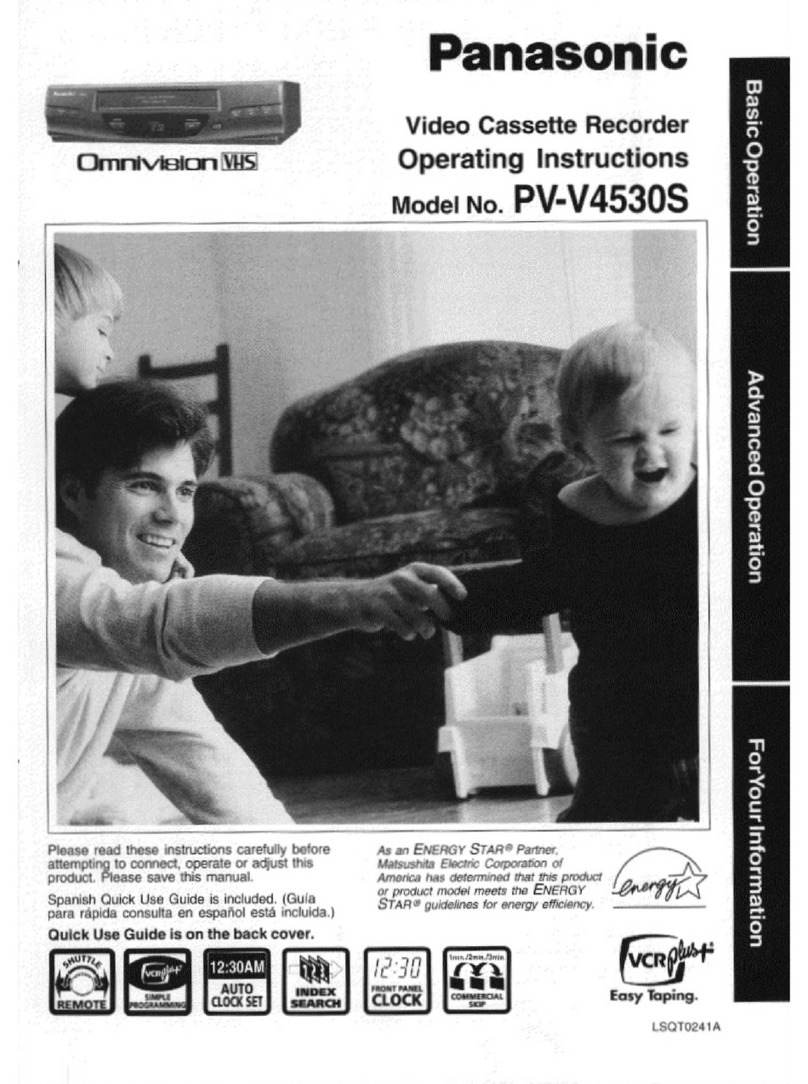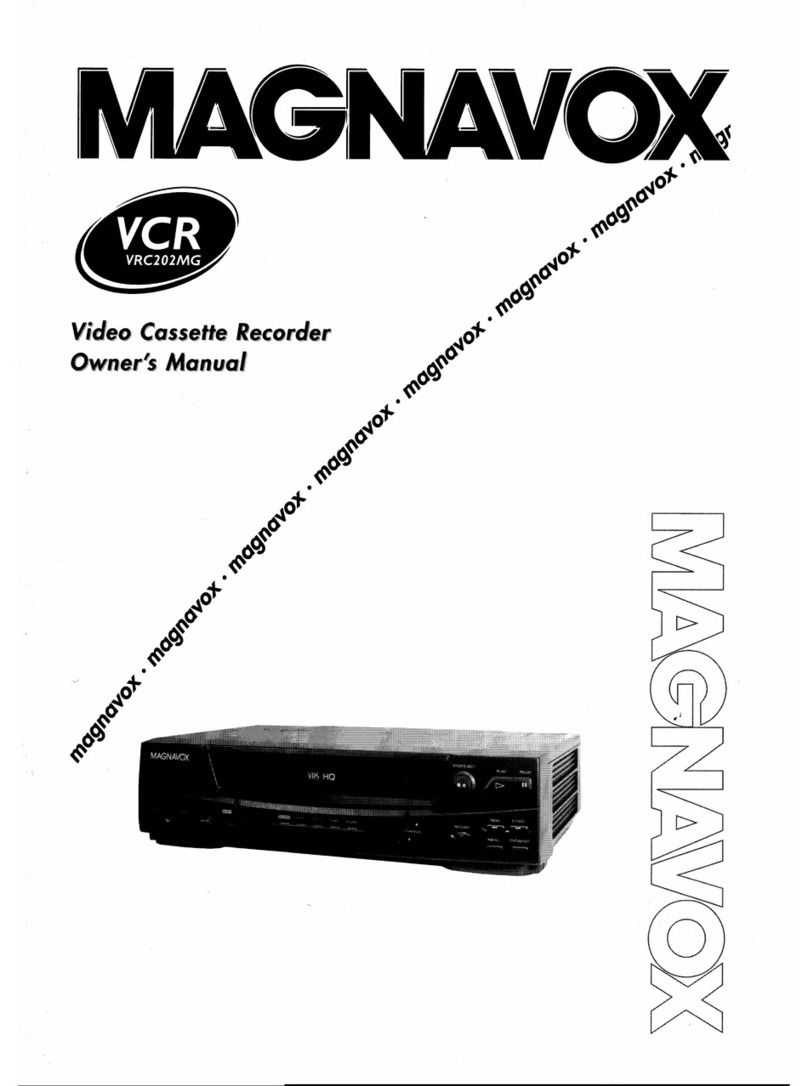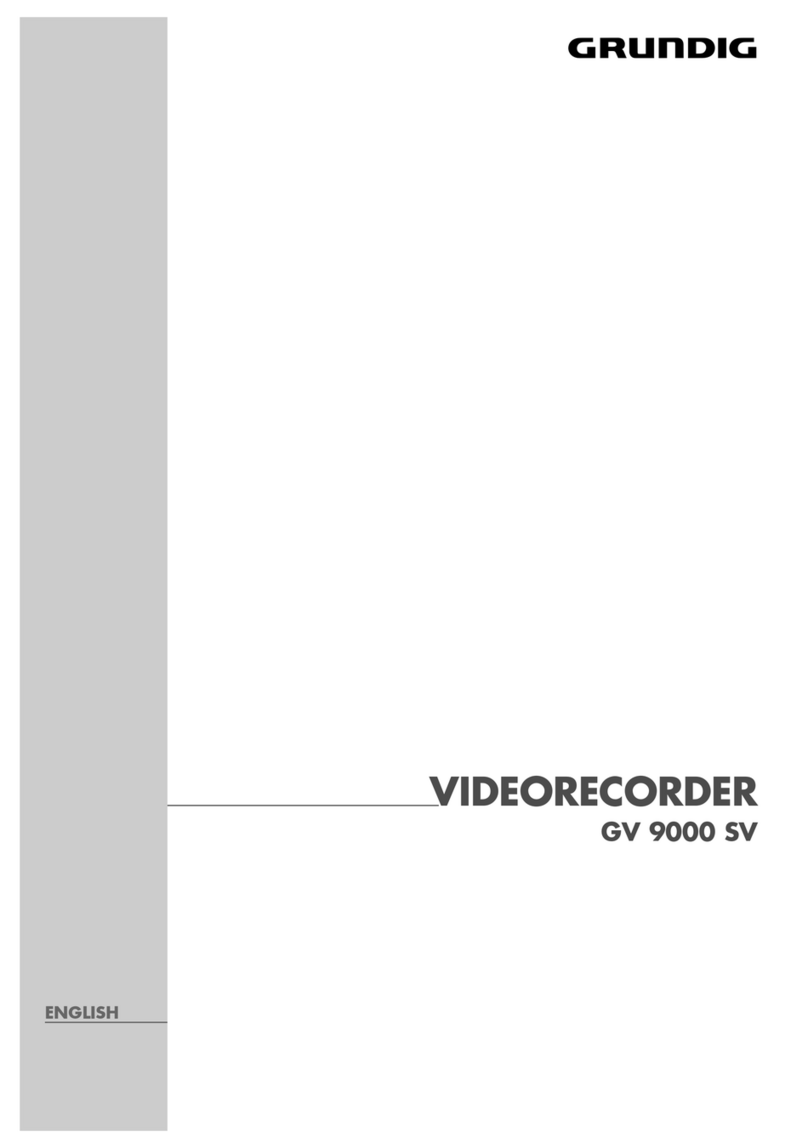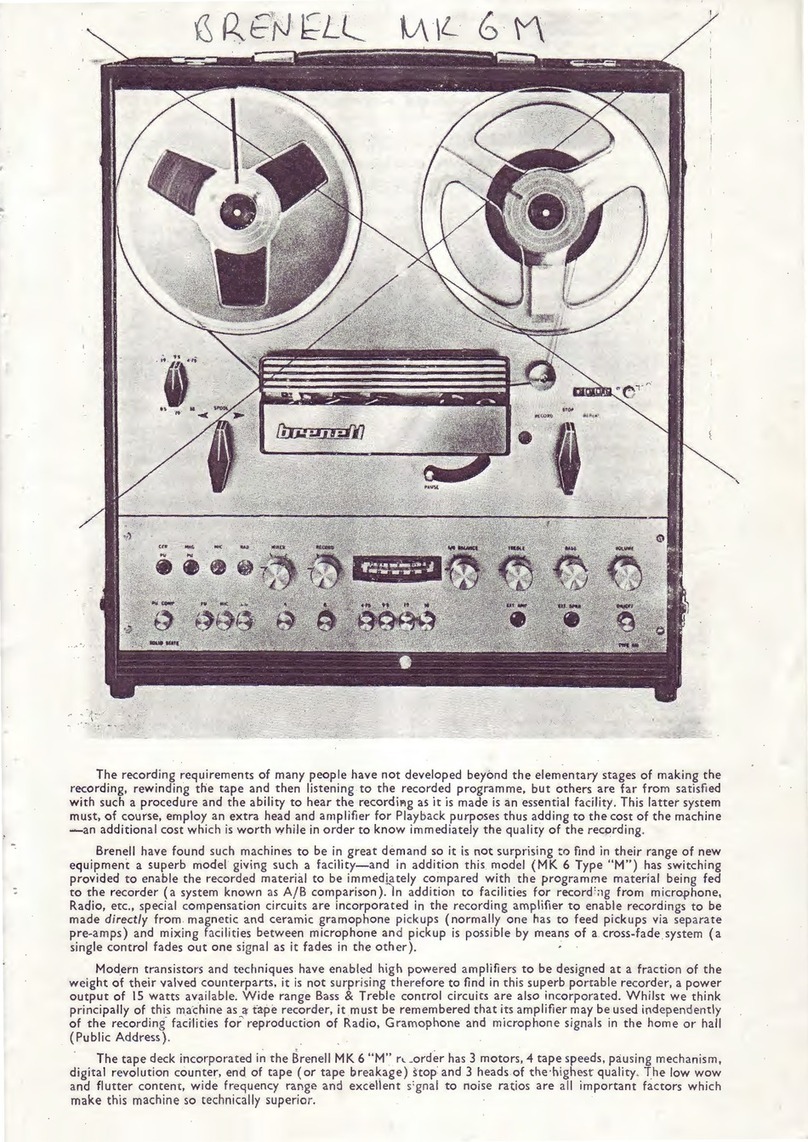TANDBERG 12 User manual

,*;y
T).^oW,*^q
r=-r=f-rr5r/
Service manual
MNDBERG
Tape recorder
modell 12

Preface
Thisservicemanualcovers
the Tandbergtaperecor-
der
models
l2-4 and12-2.fhe model
seriesl2 isa
fully transistorised,three speedstereo,
record
arrd
playback
unitwith two heads.lt is equipped
with
separaterecordand
playbackpreamplif
iers
and
sepa-
rate power amplifiers
for eachchannel.The power
output
amplifiersarerated
for l0 watts
each.
Themodel 12 -2 is the two-track
versionwhile the
model I
2-4 is the four-trackversion.The models
12-2 and )2-4 haveexaclly
the samemechanical
systemand
operatingcontrols.
We hopethot
everyoneconcerned
with our products
will find thisservicemanual
useful. April
1967
1
1

T'r
Contents
Technicol specificqlion, Tondberg tope recorder models
l2-4 ond l2-2 .
The function of the conlrols
The inpuf ond outpuf lerminols
The mechonism, detoiled descripiion ond odiusiment
instruciion
The operoling lever . .
4.I.1 The moior switch
1.1.2 lhe eccentric segment
4.1.3 The pressure wheel ossembly
4.1.4 The tope broke
4.1.5 The trip bor
4.2 The
turnfoble
ossemblies
^ 4.2.1 lhe supplyturnfobleossembly
r 4.2.2 lhe lope iight lension .
4.2.3 The
toke-upturntoble
ossembly
A.2.4 Horizontsl
ond veriicql olignmentsof the furntobles
1.3 Clulch olignments
4.3.1 Generol
4.3.2 Fost rewind
4.3.3 Fost
wind
4.3.4 Normql forword drive . .
4.3.5 Neutrol
4.3.6 Free
4.4 fhe motor pulley
4.4.1 Threoding of the rubber drive belt
4.5 The speed lronsfer wheel
4.6 Thelifting
mechonism..... .'.... '.. 19
5.2.1 The funclion selecior swilch
5.2.2 lhe speoker selector swilch .
5.2.3 Monourol recording on CHI or CH2 , .
5.2.4 Mixing during monourol recording
5.2.5 Stereo recording
5.2.5Monourol
ploybock,chonnel
I or 2 .. '....,.
5.2.7 Stereoploybock 33
5.2.8 Stereo
omplifier 33
5.2.9 Add o irock . 33
S.2,l0Sound
on sound 34
5.3 Heod
olignment
ond frock
conlrol
with Tondbergtest
tope 34
5.3.I The
Models
l2-4 and12-2 .......... 34
5.3.2 Themodel l2-2 35
1.0 3t
3l
32
32
33
a?
33
32
35
a5
35
35
5.5
5.6
35
36
36
36
36
35
36
2.O
3.0
4.O
1.1
e
9
9
't0
l0
12
t2
t2
IJ
l3
t4
l5
'15
't5
l6
l6
17
t7
l8
't8
l8
l8
JJ
JJ
AE
)
4.9 The momenlqry stort-stop feoture
4.10 The pressure pqd . . .
4.l l The oulomotic end sfop switch .
4.12 The revolulion counler .
4.13 Assembling the fop cover
5.0 The electroniccircuits,
detoiled descriplion ond odiusfmenl
instruction
5.1.1 lnpuls
5,'I.2 The record pre-omplif
ier
5.1.3 The FM multiplex-filter
5.1.4 The equolizing omplifier in record posiiion . '... ' 25
5.1.5 The equolizing omplifier in ploybock position . .. . 26
5.1.6 The equolizing omplifier in omplifier posilion . .. . 27
5.1,7 lhe power oulput omplifier 28
5.1.8 The ploybock pre-omplifier 29
5.1.9 The record level indicotor circuit .. 29
5,l.l0The oscillotor, bios ond erose circuit 29
5.l,ll The power supply 30
5.4 Heod olignment without Tqndberg test topes
5.4.1 Demognetizing
5.4.2 The odlustoble tope guides
5.4.3 The record/ploybock heod
5.4.4 The erose heod
Trock conlrol, model l2-4 without Tqndberg test lqPes . -
5.5,1 The record/ploybock heod
5.5.2 The erose heqd
Trock conlrol, model l2-2 without Tondberg lesi topes ..
5.6.1 The erose heod
5.6.2 The record/ploybock heod . .
Electrical
qdiustments for Tondberg tope recorder models
12-4 ond 12-2 . .
5.7.1 Adiustment of ihe Power outPuf omplifier
5.7.2 Adiusfment of the outpui level
5.7.3 The quiescent currenl .
5.7.4 Adiustment of the FM MX-filter
5.7.5 Control of lhe frequency response in omp' position
5.7.6 The boss conlrol
5.7.7 The ireble control
5.7.8 ,Adiusfmentof the record currenf ond the eleclronic
beqm indicotor circuits .
The electronicbeqm indicolors
The record current.
Adivstment of the osc, frequency ond the bios ..
Dislortion
Bolonce odiustment of lhe pre-omP ouiPuts
Adiusiment of the equolizoiion coils Ll ond L2 '.
Control of the recording curves .
Control of the ploybock curves .
Control of the lotol frequency resPonse
Power oulpul control .
Speed test
36
36
5.7
1.7
1.9
The flywheel with ihe copston
4.7,1 The broke for the flywheel
The speed chonge mechonism . . .
20
21
)O2l
22
22
22
22
24
24
25
25
36
1A
37
38
2a
Jd
39
39
39
5.7.9
5.7.
r
0
5.7
.tI
5.7.12
5.7.13
5.7.1
4
5.7.15
5.7.16
5.7.17
5.7.18
5.7.19
'l
,1 i
.t t
t
T
t{
tI
tt
5.8 Electricol
modificotionsintroduced
to the tope recorder
model
12 .....
...' 40
5,9 Modificolions
from four-trock
to iwo-frock
models.
.. ... 41
5.10 Modificofions
from 220volts50 c/sto ll0 volfs
60 c/s .. 4l
6.0 Portslist .'.....". 4l
6.0.1 Mechonicol
ports 4l
6.0.2 Elecrricolports ' . 46

1.0Technicalspecification,
Tandbergtape
recorder
models
12-4and12'2
Power
requirements: 220 volts50 c/s.
Power
consumption: 58watts
at2 X 1
,25
wattsoutputpower.
i 00 wattsaI2 X .l
0 wattsoutput power.
Motor: Four
pole.
Tapespeed: 71/2,33/t
and l7/einches
persecond.
The
amplifiersareequalized
to conform
with
NABstandards.
Playingtime: Four-trackrecordingson 1200ft.of tape:
Model
l2-4' Tapespeed
7Vzi.p.s.:Stereo
2
X 32 min.
Mono4
X 32min'
Tapespeed
37+i.p.s.:Stereo
2X 64min.Mono
4X 64min.
Tapespeed
l7/oi.p.s.'Stereo
2x 128min.Mono
4X i
28
min.
Model
l2-4: Two-trackrecordingson 1200ft.of tape:
Tapespeed
7t/zi.p.s.:
Stereo 32 min.
Mono
2
X 32 min. A
Tapespeed
3% i.p.s.:Stereo 64 min.Mono
2
X 64 min.
Tape
speed
17/6
i.p.s.:
Stereo
.l28
min.Mono2
X .I28
min.
Fastwind andrewind: Thefastwind or rewindof .l200
ft.of tape
takesapprox.
2 minutes.
Tape
path: Thetape moves
from left to right. The headsare positioned
with the air gaps
pointing
towards
thefrontof thetaperecorder.
Recordingtape: Maximum
reel
diameter
7". Good
qualityrecordingtape
isrecommended.
Automatic
slop: The
auiomatic
stopoperaies
during
record
or playback
aswell asduring
fast
wind
or rewind
modes.
Heads:
Modell2-4: Quarter-track
erase
head.
Quarter-track
combined
recordandplayback
head.Air gap: .003mm (.O012").
Model
I2-2: Half-trackerase
heao.
Half-trackcombinedrecord
andplayback
head.Air gap: .003mm (.00012').
Frequency
response: 7'
l, i.p.s.30-20.000c/s
('l 2 dB
40- 16.000c/s).
33/ai.p.s.30- I3.000
cls
(-r2 dB50- I
0.000
c/s).
17/ai.p.s.30- 2.000
c/s
(+2 dB
60- 5.000c/s).
lnAMPLIFIERoosition:t 2 dB30-.l6.000c/s.
Distortion: Thedistortionfromthe
record
amplifiers
isless
than
.5
%.
Thedistortionfromthe
playback
amplifiersis
lessthan
.5%. i
Signal
to noiseratio
Model
l2-4: Thesignal
to noiseratio
is
better
than
55 dBwhenthetapeis
recordedto optimum
recordinglevel,i.e.nearlyclosingof the electronic
beamindicator
(5% disloriion
fromthetape).
Model12-2' The
signal
io noiseratioisbetter
ihan
58 dBwhen
the
tapeis
recordedto optimum
recordinglevel,i.e.nearlyclosingof the electronic
beamindicator
(5
% distortion
fromthetape).
Crosstalk: The
crosstalkreiection
is
better
than
60
dBat
400
c/s.
Wow and
flulter: Betterihan.I % at7t/z
i.p.s.tape
speed. I
Betterthan
.15%at
33/+i.p.s.
tapespeed.
Belterthan.25
Y"
al l'/o i.p.s.tape
speed.
Eraseand
biasfrequency:The
erase
andbiasfrequencyis85,5kcls.Theevenharmonicdistortion
in the bias
currentislessthan.5%.
Recording
levelindicaior' Theelectronicbeamindicatorsareequippedwith dampingcircuits.Theindicator
rangeis
25 dB,plus
overload.
The
indicatorsareclosing
atoptimumrecordinglevel
(5
%distortion
fromthetape).
lnputs: 2 Microphone
inpu?s
(ch.
I and ch,2l:
lmpedance,200
ohmsunbalanced.Sensitivity:
l50pV. Dynamicrange *40d8.
Contacts:5 pinDINcontacts.
4

Oulputs:
Speakers,
Bass
control:
Treble
control:
Momentary
start/stop
tever:
Counter:
Tubes
models
l2-4
and
l2-2:
Transi
stors:
Rectif
iers:
Dimensions:
Weight:
2 line inputs
(ch.
I andch.
2):
HIGHLEVEL:
Impedance:I Mohm.
Sensitivity:
75
contacts
and DIN connector
marked
LOW
LEVEL:
mV. Dynamicrange+40 dB.
Contacts:Phono
CRPHONO
(pin
No.
3 and5).
lmpedance:
.l00
kohms.
Sensitivity:
7,5mV. Dynamic
range *40 dB. Contacts:
Phonocontactsand DIN
connector
markedRADIO
(pinNo. I and4).
FM-Multiplexinpuls:
Themodell2 taperecorderisfurnished
with a FM-Multiplex
switch
which
switches
themultiplexfilter
in
oroui.
The
switchcontrols
all
inputs.
PlaybackPreamplifier
oulpul:
lnternalimpedance
is5 kohms.Opencircuitoutputvoltage750 mV, independent
of the setting
of all switches
and controlsduring playback.
Two phonocontacts
(ch.
I and
ch.2) arefurnished
for connection
to external
poweramplifiers.
low lmpedance
oulpul:
Externalimpedance
is4 ohms.
Two standard
telephone
iacks
(ch.
I and ch.2) in
parallel
with two DINloudspeakercontacts
are
furnished
for connection
to external
loudspeakers.
Cenler
Channel
oulpul:
lmpedance
is 82 ohms from each amplifier. Output voltage in record posi-
tion is 75OmY open circuit.Output voltagein playback
positionand amplifier
position
(AMP)
is maximum3 volts
opencircuit.One standardtelephone
iack
in
parallel
with one DIN loudspeakercontact
arefurnishedfor connectionto head-
pnones.
Power
ouipul:
Maximumoutput
power
is I0 wattsin eachchannel.Twostandardtelephone
iacks
(ch.
I and ch.2) in parallelwith two DIN loudspeakercontactsare furnished
for
connectiontoexternal
speakers.
Twospeakers
7" X 4".
Thebassresponse
canbe continuously
increasedapprox.l2db at 80 c/s
during
playback
or in amplifiermode.This
increaseof the low frequencyamplification
will only be presented
on fhe channel
which issetfor playback
or amplification
evenwhen
the
other
channelisconnectedfor recording.
Thetreble
response
canbecontinuously
decreasedapprox.15 dBat I5 kc/sduring
playback
or in amplifier
mode.Minimum bassand maximum
treblecorrespondto
f
latfrequencyresponse.
The
momeniarystart/stop
lever
starts
or stops
the recording
or playback
instantly.
The4 digitcounter
shows
thenumber
of revolutionsof thetake-upturntable.
2 EAM86.
2 pairs
of complementarylransistors
AC 127,AC 128 (alternatively
AC 127,
AC r52).
2 pairs
of matchedtransistorsAD 150
(alternatively
AD 149
orSTF
213).
l0ea BC1098, 2 ea BC
114, 6 ea BC113, 2ea BC
1078, 2ea SE6002,
i ea
Tl
3030,
4 ea
284812.
Bridgerectifiers:
I ea
B
40 C
3200.
I ea B250 C 75/30 KP.
Inteakcabinetl5' I
u"
long,I l" f
,u"
wide and67/u"high.
Approx.23 lbs.

2.0Thefunctionofthecontrols
l. Treblecontrol:
2. Basscontrol:
3. Volumecontrols:
4. Recordlevel
indicators:
7.
Microphone
inputs:
Frontandrear
trimcovers:
Momentarystart/
stop
lever:
Functionselector
switch,channell:
,+1
Fig. l. The operoling conlrols.
Decreases
the treblecontinuously.Maximumtrebledecreaseis approx. l5 dB at
l5 kcis.The
treble
control
is
operative
during
playback
and
inAMP
position.
lncreasesthebasscontinuously.Maximum
bassincreaseisapproi. l2 dBat 80 c/s.
Thebassconirol
is
operative
during
playback
and
inAMP
position.
Conirols
the recording
gain in recordmode and the outputvolume in playback
mooe.
Upperknob:Channel
1
((Upper
track).
Lower
knob:
Channel2 (Lower
track).
lndicatesthe recordinglevel. Optimum recordinglevel is obtainedwhen the
electronicbeam
indicatorsarenearlyclosed.
Left indicator:Channeli (upper
track).
Right
indicator:
Channel2 (lower
track).
Low
impedance
inputs
(200
ohms)
channelI andchannel2.
Removethetrimcoverstocleanor demaqnetize
theheads.
Stopsthe recordingor playback
instantlywhen the lever is movedto the right
position.Therecord
or playback
will start
immediately
when the leveris moved
toleft
posiiion.
4,
6.
8. Activatestheelectroniccircuitsfor record,
playback
or amplifiermode,channell.

9. Funclionseleclor
switch
channel2:
'l0. Automatic
end
stop
switch:
Il. Speakerselector
switch.
12. Tapecounter:
13. Operatinglever:
14. Re-set
push
button:
; 15. Power
switch:
'I
6. Speedselector:
Activates
theelectroniccircuitsfor record,
playback
or amplifiermode,channel
2.
Stopsthemotorwhen
thetaperunsoutor if thetape
breaks.
EXT:Externalspeakersonly.
EXT* INT: External
and
internal
speakers.
INT:Internalspeakersonly.
CHI EXT,
CH2 INT:Theoutputfrom CHI is connectedto both external
speaker
terminals.Theoutput
from
CH2
is
connected
toboth
internal
speakers.
CH2 EXT,
CHI INT:Theoutputfrom CH2 is connected
to both external
speaker
terminals.
TheoutputfromCHI isconnectedto both
internal
speakers.
Indicates
the
position
of thetape.
Activates
the mechanism
in the lape recorderfor the different modesof operalion.
Re-setsthetape
counterfo zero.
Switches
themainsonoroff
.
Selectsthe requiredtape
speed.
3.0Theinput
and
outputterminals
The input and outpul terminals
togetherwith the
FM-MXfilter and the pre-amplifier
balance
adiust-
ment arelocated
at the rear
of the tape recorder
ref.
fiq.
2 and
3.
MX-FILTER
SWITCH
cH.z cR cH.1
LOW PHONO RADIO LOW
Fig.
2.
The
inputterminols
ond the FM-MX
filterswitcn.
PREAMP. BALANCE4 OHMS
OUTPUTCH.1 ADJ. SPKR.
CH.2
cH.1
HIGH
CH.2
HIGH HEAD. 4 OHMS
PHONES SPKR.
CENTERCH. CH.1
a
PREAMP. 4OHMS CENTER 4.
OHMS
OUTPUT
CH.2 SPKR
cH.2 CH. SPKR
cH.1
iqi
$;r{ii
:,1 i! I
Fig.3. The output terminols ond the bolonce odiustment.

MICROPHONE
INPUT5
The
modelseries
l2 is available
with two different
microphonecontacts.
TheEuropean
versionisfurnished
with DIN connec-
torsref
.
fig.4.
TheUS
version
isfurnished
with standard
telephone
iacks
ref.
fig.5.
Both versions
have the same specification:
Inpul
impedance
200 ohms unbalanced,
input sensitivity
150
trv.
Fig.4. Fig.5.
A
((.t '))
\t/cH2
@)
VcHt 200
n
Mtc
4.0The
mechanism,
detailed
description
and
adiustment
instruction
Themain
functionof the
mechanical
systemis
todrive
theturntables
and the capstan
in the different modes of tape molion. Themechanical
function is activated
by theoperating
lever.
+
{,
$
ass
a
F
Fig. 6. Top view, wilh lop cover removed.

4.I THE
OPERATING
LEVER
The
operatinglever(54.1)
hasfive positions
and is
located
atfhe right front cornerof the tape recorder:
Normalforward
drive,fast
forwarddrive,fastrewind,
free,andneutral.
The
operatingleveractivates
thefollowing
parts:
Themotor
switch
(33.2):
disconnectsthe power to the
motor (14.1)
in neutral
or
free position
of theoperating
lever,and activates
the elec-
tronicbeam
indicator
in nor-
malforward
drive,
whenthe
fape recorder
isset
to record
mode.
);Theeccentric
segment
(59.17)l guides the pressure
wheel
assembly
(5.l.3)
andthe lift-
ing arm
(59.i8).
activafes
the clutchesunder
both turntables
(65.1
, 65.2).
)
Thetrip bar
(52..I):
4.1.1 Themotorswitch
Themicroswitch
(33.2)
islocated
on the bracket
(54.9)
for theoperatinglever,
ref.fig. 7. The
switch
iscon-
nectedin series
with lhe motor
currentandisactivated
by theoperating
lever
(54.i)to shut
off the motorin
neutral
or free position.
The motor switch
also
dis-
iF connectsthe power to the electronic
beam indicafors
in neuiral
or freeposition
when thefunction
selector
switchesare setto record.
Adlustments
Theoperating
point
of the microswitch
(33.2)
should
besetaccording
tofi9.8.
Themotor
should
start
when
the operatinglever
(54..|)
is moved
from neutral
to
eithernormal
forward, fasl wind or fast rewind posi-
tion.Unscrew
the
three
screwsA, B,
andC ref.fig.7.
Adiustlhe horizonial
position
of the delrin bracket
(33.5) and ihe vertical position of the microswitch
(33.2)
obtaining
proper
positions
for correct
operating
poinl.
Fig.7, The operoling lever.
MICRO SWITCH
OPERATING POINTS
77^
/ z"\
77-
(.
3'.)
---l>
OPERATINGLEVER
IHLL
Fig. 8. Adiusimeni of the operoting points for the microswitch.

4.1.2 The
eccenlricsegmenl
The
eccentric
segment
(59.17)
is located
underneath
theuppermounting
plate
(71.2),
and isconnected
to
the
operating
lever
(54.1).
Ref.
fig.9 and 10.
The eccentric
segment (59.17) moves the pressure
wheelassembly
(5.|.3)
with thepressure
wheel
(5
l.l"
against
the capstan
(66.2)
when the operating
lever
(54.'l)
isbeingset
to normalforward
drive.
The
liftingarm (59..l8)
is linked
to theeccentricseg-
ment (59.17)
and releasesthe speed
transferwheel
(53.1)
from contacting
the moior pulley(62.1)
in all
operating
modes,except
in the normalforward drive
position.
+
Fig.9. The upper mounling plole, bollom view.
Adiustments
Adiustthereturn
sembly
(51.3)
by motion
of the pressure
wheel as-
bending
the lug (A) ref.
fig.9 to
ascertaineasy
threadingof the tape in the slot be-
tween the two trim covers (73.1
, 73.2). The tape
should
not
stick
againstthe
pressure
wheel
(5
I.l
)dur-
ing
thethreading.
4.1.3 Thepressure
wheel assembly
The pressure
wheel assembly
(51.3)
is guided into
operating
position
by the eccentricsegment
(59.17)
when the operating
lever
(54.1)
is movedto normal
forwarddrive.
Thepressure
wheel
(51.1)
ismountedunderbalanced
springtension,with the pressure
wheel shaft
(5
1.2)
runningthrough two oblong slots in the pressure
wheelbracket
(5LI2). This
mouniing
gives
the pres-
sure wheel (51.1) approx.6 mm (t/a") horizontal
springloaded
play,
on
aline
perpendicular
tothe
front
of the upper
mounting
plate
(71.2).
Ref.fig. 10.
Adiustments
The balanced
spring
tensionof the pressure
wheel
(51..|)
is adjusted
to obtain
uniform pressure
of the
pressure
wheel againstthe capstan.Loosenscrew E,
and
turn the spring
equalizationlatch
(51.1
l) clock-
wiseor counterclockwiseuntilthetape
runs
smooth-
ly by the pressure
wheel (5
l.i) in normal
forward
drive. Make surethat no air-pockets
are formed be-
tweenthe tape and the pressure
wheel (5
l.l) and
that
thetapeiscompletely
coveredby ihe rubbersur-
faceof thepressure
wheel.
Ref.fig. l0 and I1.
10
l(
t
Fig. I0. The pressurewheel
ossembly, exploded view. tr --@

AZIMUTH
;oii'J'Jil*'),u.,
Fig. Il. Mounling of the heods with the pressure
wheel ossembly.
tr
uc
t E/
sriQ
Lb"l
,,*3
xfx
&r
iatg
,4$
s
'?1't.:
Fig. 12.The lower mounting plote, wi'lh the turntobles removed,

4.1.4 The
tapebrake
The
tape brake
(51.9)
is located
inside
the pressure
wheelassembly
(5
1.3)and
isactivated
by thepressure
wheel
lever
(51.5).
Ref.
fig. Il. Thetape
brake
(51.9)
prevents
the tapefrom creeping
when the operating
iever
(54.1)
isin normal
forwarddrive,
with the mo-
mentarystart-stop
lever in stop position(right posi-
tion).
Adlustments
Set
theoperating
lever
(54..|)
to normal
forward
drive
and the momentary
siart-stop
lever to the stop posi-
tion,with tapeinserted.
The
tape
brake
(51.9)
should
preventthe tape from creepingwhen the pressure
pad
arm
(59.2)
is
pulled
away
fromtheerase
head.
Start
fhe mechanism
by moving the momentary
start-
stop leverto the left position.Thetape brake (5.|.9)
should
becompletely
disengaged.
Adiustthescrew
F
until
the spacing
between
the tape brake
(5.I.9)
and
therecord/playback
headisapprox.
2 mm (.08").
+
4.1.5 Thetripbar
Thetrip bar
(52.1)
islocated
across
the lower mount-
ing plate(71.1),
and linked to the operating
lever
(54.1).
Ref.fig. 12.
The
trip baractivates
theclutches
underneath
both turntables
(65.1
, 65.2)
by a sliding
motion. The vertical position of the two clutches
is
determined
by theraised
areasof thetrip bar(52.1).
4.2 THE
TURNTABLE
ASSEMBTIES
Thedesignof the turntable
assemblies
is shown in
fig. l3 and 16.
Theturntable
assemblies
arebuilt up
around
the two housings
for the turntable
bearings
(65.3).
The
housings
for theturntable
bearings
(65.3)
are
rivetedto the
lower
mounting
plate
(71.1)'
4s
@
12
Fig. 13. The supply lurntoble ossembly, exploded view.

-
4.2.1 Thesupply turntable assembly
The
supplyturntable
assembly
isput together
by first
inserting
thehelical
compression
spring
(61.7)
and
the
pulley
disc
(6.|.2)
overthe housing
(65.3).
Makesure
thaf
the compression
spring
(6i.7) fits intothe sylin-
drical
groove
in thecartridge
(6.|..l1).
The
two delrin
lugs
and
thetongue
on thecartridge
(61.11)
should
lie on a line perpendicular
to the front edgeof the
uppermounting
plate
(71.2),
with the delrin
tongue
pointing
towards
the front. Press
down the pulley
disc
(61
.2)unfilthe
delrinlugs
onthe
cartridge
(6l
.ll
)
have passed
through the notch in the clutch lever
(59.6).
Turnthe cartridge
(61.1
l) 90o counterclock-
wise.
Make
surethatthe two delrin lugs
have
been
locked in positionby the claws on the clutch lever
(59.6),
and that the tongue
on the cartridge
(6l.l l)
fits intothe groove in the clutchlever(59.6).
Ref.
fig.
13and
14.
lnsert
the flange
for the turntable
housing
(72.2)
by
pressing
it intothe upper
endof the housing
(65.3).
Place
the mylar
sheet
(61.4)
on the top of the pulley
disc
(61.2),
and insert
the two springs
(61.9)
in the
wells.
Attach
thetape
tightdisc
(61.6)
with theshort
pins
inside
the
two springs
(61.9)
andinsert
theturn-
table
(65.2).
Ref.
fig. 15.
Moveihe operating
lever(54.'l
)to the fastwind posi-
tion.
This
will allow
the
supplyturntable
(65.2)
rorest
on the
flange
(72.2).
Insert
one
teflon
washer
(M355)
on the turntable
shaft, under the lower mounting
plate
(71.1),
beforethe delrin nut (65.5)is
attached.
Ascertain
anaxialplay
in
the
turntable
shaftofapprox.
0.1mm (.0t"1.
Fig.
15.
Thesupplypulley
disc
wirh rhe
mylor
sheer.
4.2.2 Thetape tight tension
A slightpermanent
clockwise
torqueof the supply
furntable
(65.2)
has
beenintroduced
to prevent
atape
loop from being formed between the supply turn-
table
(65.2)
and
thetrim covers
(73.1,73.2)
whenrhe
operating
leveris in normal
forward drive,
and the
sfarf-stop
lever is operated.The
tapetight disc
(61.6)
isa spring
loaded
friction
discthatpresses
against
a
green felt washerunderneath
the supplyturntable
(65.2),
ref.
fig. 13.
Adiustments
The adiustment
is made by stretching
or cuttingthe
two springs
(61.9).
The
torque
shouldbe iustsuffi-
cient
to take up the loop formed when the operating
lever
isin normalforward drive,and
thetaperecorder
stoppedby ihe momenlarystart-stoplever.
Thetape
recorder
shouldbe loaded
with a full 7" tape reel
on
thesupply
turntable
(65.2).
Nofe: Do not increase
this torque unnecessarily,
as
excessive
torque might introducewow and
fl
utter.
a
Fig. 14.The supply pulley disc wiih the clutch lever.
13

4.2.3 Thetake-up
turntableassembly
The
take-upturntable
isputtogether
byf
irstinserting
the helical
compression
spring
(6.l.8)
andthe pulley
disc
(61.1)
over the housing
(65.3).
Make surethe
compression
spring (61.8)fits into the sylindrical
groove
in thecartridge
(61.11).
Thetwo delrin
lugs
and
thetongue
onlhe cartridge
(6.l
.l I
),
shouldlie
on
a line perpendicular
to the front edgeof the upper
mountingplate
(71.2),
with the delrintongue
point-
ing
attherear
edge
ofthelower
mounting
plate
(71
.l
).
Press
downthe
pulley
disc
(61.1)
untilthe
delrinlugs
onthecartridge
(61
.I 1)have
passed
through
thenofch
intheupper
clutchlever
(59.7).
Pressthe
lowerclutch
lever
(59.8)
allthe
way down by usinga screwdriver.
The
spacebetween
the two clutch
levers
(59.7, 59.8)
will now be approx.6 mm 1t7o"'1.
Turnthe cartridge
(61.1l)
90o clockwise,and make
surethatthe two
delrinlugshave
beenlocked
in position
by theclaws
onethe lowerclutchlever
(59.8).
Ref.fig. l6 and 17.
Fig. 17.The toke-up pulley disc with the clufch lever.
f
nsert
the flange
for the turntablehousing
(72.1)
by
pressing
it intothe upperend of the housing
(65.3)
and
inserttheturntable
(65.1).
Move the operatinglever (54.1)
to the fast rewind
position.
Thiswill allow the take-upturntable
(65.i)
to rest
on theflange
(72.1).
lnsertoneteflonwasher
(M355)
ontheturntable
shaft,underthelower
moun-
ting plate
(71..|)
before
the pulley
(69..I)
isattached.
Ascertainan axial play of the turniable shaft of
approx.
0.1mm(.04").
f
f
14
Fig.
16. The toke-up iurntoble ossembly, exploded view.

4.2.4 Horizontal and vertical alignmenls
of theturntables
UsethespecialtoolsI
, 2, and3 for thesealignments.
Ref.fi9.65.
Horizontal
alignmenls
The horizontal
positionof the two lurnlables (65..|,
65.2)
parallel
to the lower mounting
plate(71..l)
is
checkedby placing
the special
tool No. I acrossboth
turntablesas shown in fig. lB. Thereshouldbe no
spacingbetweenthe ruler
(tool
No. i) and the turn-
tables.
Necessary
adiustments
aremade
by bending
theturn-
table
housing
in correct
position.
Usethespecialtool
No.3,
asshown
infig.19.
Thehorizonfal
position
of bothturntables
(65.1
,65.2),
parallel
to a line perpendicular
to the front edge of
the upper
mounting
plate
(71.2)
ischeckedby using
the
special
tool
No.2.
The
edge
of thespecialtoolNo.2 shouldrunexactly
intothetape
groove
inthe
guide
(79.13,79.1
4),when
the operatinglever(54..l)
is in the neutral
position.
Ref.fi9.20.
Necessary
adiustmentsaremadeby bending
the
turn-
tablehousing
(65.3)
in correct
position.Use
special
tool
No.3,as
shown
infig. 19.
Vertical
alignments
Thehorizontalposition
of theturntables
must
be set
before
lhe verticalalignment
ismade.
The
vertical
position
of theturntablesis
checked
with
thetapethreaded
onthe recorder.
Thetape
should
not
touch the edgesof the plastic
reelsin any mode of
operalion.
Theturntablesareraised
or lowered,
if necessary,
by
adding or subtractingturbax washers(M306-7)be-
tween
theflange
forthe
turntable
housing
(72.1
,72.2)
andthe
turntablehousing
(65.3).
Ref.fig. 13and 16.
A final check
of the horizontal
position
of the turn-
tables
shouldbemade.
G
t
Fig. 19. Alignment of the horizontol position of the turntobles
with fool No.3.
Fig.20. Control of the horizontol position of lhe turntqbles
wilh tool No.2.
Fig.18. Control of the horizontol position of the turntobles wilh iool No. l.
SPECIALTOOL NO,2
4.3 CLUTCHATIGNMENTS
4.3.1 General
Themotor
will alwaysrunand
driveboth
pulley
discs
(61..|,61.2)
whentheoperating
lever
(54.1)
isset
fo
either
normalforwarddrive,fastwind,orfastrewind
position.
Thetwo pulley
discswill runinthe
opposite
directionscaused
by thecrossthreadingof the rubber
drive
belt
(62.2).
Ref.
fig. 6.
The
torque
of the turntables
(65.1,
65.2)
isobtained
by the
fricfionbetween
the pulley
discs
(6i.1,61.2)
and
thefeltrings
glued
to theturntables
(65..I
, 65.2).
Thefrictionbetween
the pulley discs
and the turn-
tables is determined by the position
of fhe cluiches
mounted
undereach
pulley
disc.Theclutchesare
ope-
ratedby thetrip bar(52..l),
which isconnecfed
to the
operatinglever
(54.
I
).

4.3.2 Fast
rewind
.^.\
:'v'-^1,
':':'
Fis.
2l
.
Thesupply turntable
The
supply
turntable
(65.2)
hasmaximum
obtainable
friction
with
the
pulley
disc
(61.2)
inrhis
position.
Ref.
fi7.21.
The
pulley
disc
(6.l.2)
ispressed
againstthe
turntable
(65.2)
by lhe entiretension
of the
compression
spring
(61.7).
Thetrip bar(52..l)
has
moved,
and
the delrinbutton
(59..|9)
ontheclutch
lever
(59.6)
is
aithelowest
posi-
tion.
Thetwo delrin
lugs
on
the
cartridge
(6.|.1l)
and
theclutch
lever
(59.6)
are
disengaged.
Adiustments
Adiust
the heighiof the clutch
lever (59.6)
by ihe
screw
(A)until ihe clearance
between
the-clutch
lever
(59.6)
and
the delrin lugs
on the cartridge
(6l.l i) is
approx.
0.5-l mm(.02'
-.04").
Thetorque
of the supplyturntable
(65.2)
shouldbe
min.
75 g (23/a
oz)actingon an arm of 8 cm (3y2").
Recheck
all other positions
of theoperating
leverand
finally
seal
the
adiustment
screw
A.
Fis.22.
Thetake-up
lurntable
Thetake-up
turntable
(65.1)
iscompletely
disengaged
from ihe pulley
disc
(61.1)
and
free-running
in this
position.
Ref.
fig. 22.
Thetrip bar(52.1)
has
moved,
and
the delrinbuilon
(59.19)
ontheupper
clutch
lever
(59.7)
isatthehigh-
est
position,
pressing
down both
thelowerclutch
lever
(59.8)
and
thetwo
delrinlugs
onthe
cartridge
(61.1l).
Adiustments
Adiust the heightof the upper clufch
lever(59.7)
by
the screw
(B)
untilthe clearance
between
the pulley
disc
(61.1)
and
the
feltring
on the
turntable
(65.1)
is
approx.0.5-l mm (.02"-.04"). Recheck
allother
po-
sitions
of theoperating
lever
and
finally
sealthead-
iustment
screwB.
f,
4.3.3 Fastwind
Fig.23.
The
supply turntable
The
supplyturntable
(65.2)
is
completely
disengaged
{rom the pulleydisc
(61.2)
and free-running
in this
position.
Ref
.
fi9. 23.
Thetrip bar(52..l)
hasmoved,
and
thedelrinbutton
(59.1
9)
on
the
clutchlever
(59.6)
isatthe
highest
posi-
tion,pressing
down the two delrin lugs
on the cart-
ridge
(61..ll).
Adiustments
Adiust the height of the clutch lever (59.6) by rhe
screw
(A)
until
theclearance
between
the pulley
disc
(61.2)
andthefeltring
on
the
turntable
(65.2)
isapprox.
0.5-l mm (.02'-.04"). Recheck
all
other
positions
of
the operatinglever and finally sealthe adiustment
screwA.
Fi1.24.
The
take-upturntable
Thetake-up
turntable
(65..l)
has
maximum
obiainable
frictionwiththe
pulley
disc
(61.1)
inthis
position.
The
springloaded
lowerclutchlever
(59.8)
ispressing
the
delrinlugs
on thecartridge
(61.1
l) upwards
inaddi-
tion to ihe entire tension
of the compression
spring
(61.8).
Ref.fis.
24.
Thetrip bar(52.'l)
has
moved,andthe delrinbutton
(59.19)
on
the
upperclutchlever
(59.7)
isat
the
lowest
position,
disengagingthe
lowerclutch
lever
(59.8)
and
theiwo delrin
lugs
onthe
cartridge
(6.l.1l).
Adiustments
Adiusf
theheight
of the upper
clutch
lever
(59.7)
by
the screw (B)until the clearance
befween the upper
and the lower clutch levers (59.7, 59.8) is approx.
0.5mm (.02').
The
torque
of the take-up
turntable
(65..l)
shouldbe
min.65 g(21/t
oz)
acting
on an
arm
of 8 cm
(3t/2").Re-
rhorlz rll nthar nncifinnc ^f +ho nnarr+inn l^.,^".^..1
I

t
4.3.4 Normalforward drive
Fis.25.
The
supply turnfable
The
supply
turntable
(65.2)
iscompletelydisengaged
from the pulleydisc
(61.2)
and free-running
in this
position.
Ref.fig. 25.
The
trip bar(52.1)
hasmoved,and thedelrinbutton
(59.19)
onthe
clutchlever
(59.6)
isat
thehighest
posi-
tion,pressing
down the two delrin lugs
on the cart-
ridge
(61.1i).
Adiustments
Adiustthe height
of the clutchlevgr (59.6)
by the
screw
(A)
untilthe clearancebetweenthe pulley
disc
(61
.2)
and
thefeltringon
the
turntable
(65.2)
isapprox.
0.5-l mm (.02"-.O4").
Recheckall
other
positions
of
the operating
leverand finally sealthe adiustment
screwA.
Fi9.26.
The
take-up
turntable
The take-up
turntable
(65.1)
hasa reducedfriction
with
the
pulley
disc
(61..l)
in
this
position.Thetorque
of thetake-up
turntable
(65..|)
should
besufficient
to
take-upthe tape in record
or playbackmodes.
Ref.
fis.26.
Thetrip bar(52.1)
has
moved,and
thedelrin button
(59.19)
onthe
upperclutch
lever
(59.2)
is
in
themiddle
posiiion,pressing
down
thespringloaded
lower
clutch
lever
(59.8).
The
delrin
lugson thecartridge
(61..|l)
are released
from any tension,and the pulley disc
(61.1)
is
pressing
againstthe
turntable
(65.1)
only
by
the
tensionof the
compressionspring
(61.8).
Adiustments
Adiustthe height
of the upperclutch
lever
(59.7)
by
the screw
(B)
until the delrin lugs on the cartridge
(6.l.1l) is in the center
position
betweenupperand
lowerclutchlevers
(59.7,
59.8).
The
torque
of the take-up
iurntable
(65..I)
should
be
12-25 9 ( /r-l oz)
acting
on anarmof 8 cm 131/2").
Recheck
allother
positions
of the
operating
lever
and
finally
seal
theadiustmentscrew
B.
t
4.3.5Neutral
Themotor
poweris shutoff, andthe pulley
discs
(61.1,
6.l.2)
are
notrunning.
Fis.27.
Thesupplyturnlable
The
supply
turntable
(65.2)
hasmaximum
obtainable
frictionwiththe
pulley
disc
(61.2)
inthis
position.Ref.
chapter
4.3.2,Iast
rewind.
Fis.
28.
Thetake-up
turnlable
Thetake-up
turntable
(65.'l)
hasmaximum
obtainable
friction
withthe
pulley
disc
(6
I.l
) in
this
position.Ref
.
chapter
4.3.3,fastwind.
2l
17

4.3.6 Free
The
motor
power is
shut
off and
6).2)
are
not
running. thepulley
discs
(61.i,
Fig.29.
The
supply
turntable
The
supply
turntable
(65.2)
is
complerely
disengaged
from.the
pu-lley
disc
(6.l.2)
and
fiee-running
in rhis
position.
Ref.
chapter
4,3.3,
fast
wind.
Fig.
30.
The
take-up
turntable
The
take-up
turntable
(65.1)
iscompletely
disengaged
from the_pylley
disc
(61.1)
and fiee-running
in ihls
position.
Ref.
chapter
4.3.2,
fast
rewind.
'F
Fig.
31. The olignment of the motor pulley.
4.4 The
motor pulley
Th-e
driving mechanism
with thespeed
transfer
wheel
(53.1)
engaged
in
the
17
/ 6i.p.s.track
onthe
motor
pul_
ley
(62.1)
is
shown
in
fig.3t. The
moror
pulley(O).t)
has
three
tracks
with different
diameters
ior theipeej
lr.ultfgl wheel (53..l),
corresponding
to the speeds
l'/ u,
3'/
o,
and
Zr/, i.p.s.
Adiustments
The
vertical
position
of the motor
pulley
(62.1)
isad_
justed,with
theoperating
lever
tS+.f
l in neutral
posi_
tion.
The
dividing
rib
ofthe
motorpulley
(62.1)
should
besef
0.5mm (.O2")
below
an imaginary
line
drawn
between
the bottoms
of the V-shapld grooves
in the
pulley
discs
(61
.1
,
61
.2).
18
4.4.1 Threading
of the rubberdrive belt
The
rubber
drive belt(62.2)
is
crossthreaded
as
snown
in fig. 6. The
belt is running
in fhe uppergroove
in
frontof the.pulley(62.1),
undin the lowergroove
at
the
rear
ofthepulley.
The
crossing
should
liJbetween
lhe
supply
turntable
(65.2)
and
the
motor
pulley(62.1).
4.5 THE
SPEED
TRANSFER
WHEET
The speed transfer wheel (53.1) is attached
fo the
mourting
arm
(53.3)
and
is
driven
bythe
moior
pulley
\92).).
The
speed
rransfer
wheel
(5i.t) inturn,
drives
thefly-wheel(66.
i).
The
spring
(53.5)
secures
thecon-
tactof the speedtransferwheel (53.1)betweenthe
motor
pulley (62.1)
and
rhe
flywheel(66.1).
Ref.
fiq.
6and
31.
O,5mri (o.oz".

Adiustments
The
speed
selector
bracket
(29.3)
isadiusted
until the
mountingarm for the speed
transfer
rarheel
(53.3)
is
parallel
to the lower mounting
plate(it.J) (unscrew
the two screws Ml l3). fnu"riru.ing between the
mounting
arm (53.3)
and the lo*"r. ".ounting plate
g1.l) should
be
approx..
I mm (.O4,,).
n"t. fig.
Sa.
The
vertica.l
position
"t tne.p""j tru*f"l,rn"el (53..|)
is_adiusted
by adding
or subtracting-irru.-
washers
between rhe rransfer wheel holdei (SC.Z)
and the
mounting
arm
for the
transfer
wneet
(SS.Sl.
The
spac-
ing.between
thespeed.rransfer
*n""fijg.rf and
rhe
higherspeed
track
o.n
rhe .otor. frtt-uy'iur..,) should
be approx.0.5
mm (.O2,'1
in,n" i;/.-i.p.s. and 33la
i.P.s.position.
The
vertical
position
of thespeed
transfer
wheel(53..1
)
should
be
minimum
f rnnn
t.Oa
) il"i"* in" upper
rim
of th.e
flywheel (66.1)
in ti" Z,'lr-i ps. position.
The
flywheet
(66.1)
is
titiea,
ii ne.J.r.ii,
Ui addins
an
extra thrust washer(66.g1)
in the'O*LI. flywheel
bearing.
Ref.
chapter
4.7.
The
horizontal
alignment
of the speed
transfer
wheel
(53.1)
is-adiusredLy
bendins
th;-;;;r;"; wheet
hot-
9er (5S.2)
(tool No.6) until rihe
,puJ'rr""nrter wheel
(53.1)
runs
parailel
torhe
ftywh"Jj-(-oZ.;;'
4.6 THE
I.IFTING
MECHANISM \
T.he
-design of the lifting mechanism
is shown in
fig.34.
The.
lifting arm (59.18)
ylt! the parailel
arm (53.7)
and the adiustmenf
arm (53.g)
isrocateJ
between
the
upper
and
the
lower
mounting
plates
(Zl
.2,71.1)-The
jfj']n'''.iT,ll?;t8)
is
linked
t".
*," ..i""iri. ,esrn"nt
\Jy.t
/
) wntte
theparallel
arm(53.2)
isconnected
be_
tween the lifting arm (59.
lg) and the-tia-nsfer
wheel
holder(S3.2).
The lifting mechanism
releases
the speed transfer
wheel(53.1)
from
conracrwirh
tnurnorolp,lley (62.1)
anf thg flywheel (66.1)
in ulf porir-ionsTt
,h" opu_
rating
lever
(54.1)
except
normal
forwarddrive.
Adiustments:
Ref.
fis. 34.
Loosen
screw
A. Thelifting between
the speed
trans_
fer.
wheet(53.i)
and
rhu
;;;,. ;rii"vi#.U is
indi_
ylauatly
adjusred
for the,thruu'rpu"i.'-6y
U"naing
the
splirs
X,y and
Z on
rhe
liftini arm
6,0.]A),.or-
responding
to rhespeeds
7,
1",
i"lo unJ t1u-'i.p.r.
The
lifring
is
occasioned
Uy
u'iufJi*ly"'Jmall
move-
t"nl ?f.
the
operating
lever
(54..1)
from
normal
for_
ward
drive
to
neufral.
The
lifting
,nortJ
[" .ompleted
before
the motor
current
is siut .if-JV the micro_
switch(33.3).
The
clearance
between
themotor
pulley
(62.1)
and
the
speed
rransfer
wheel(53.f
1
ar
afl
speJds
should
beminimum
3 mm
when
rh" ;p;r;;ffiJver t5a.t)
isin
neutral
position.
Set
the speed
selector
to lt/ui.p.s.
tape
speed
and
theoperaring
lever
to neutrlipiriii."Ii*n rhe
ad-
justmeni
arm
(53.8)
unril
a .p..inl ol O,i'^^ 1.92,1
isobtained
between
thespeed
trJnsfer
wheet(S3.1)
andthe flywheel
(66.1).
irr" rn" ,plej'."tu.tor. to
33/a
.and.
i'1, i.p.t'.
tape
speed
and
check
that
the
spacing_
ismin.
0,5mm1.0),,1
forOol.,
pt.itlons.
Re_
adiust
if necessary
and
re_seal
tf.'r"
uJirrt,i"it r.rurar
n.
Fi9.32.
The
flywheel
with
thebeorings,
explodedview.
rt
IG

4.7 THEFTYWHEEL
WITH THECAPSTAN
Theflywheel shaft
acts
as
the capstan
(66.2),
and is
mountedintwo selflubricating
and
selfadiusting
bear-
inss
(66.3).
Ref.fig. 32.
Adiustments
Thevertical
positionof the capstan
(66.2)
is aligned
with the special
tool No.5 insertedon top of the cap-
stan
asshown
infig.33.
The
two screws
(M.l25)
areloosened,
andcorrect
posi-
tionof the capstan
(66.2)
isobtained
when all three
legsof the tool No.5 touches
the upper mounting
plate
(71.2).
4.7.1 Thebrakefor theflywheel
The brake spring (66.6)
for the flywheel (66..l)
is
attachedto the lifting arm for the speed transfer
wheel
(59..l8).
Ref.fig. 6.
Thebrakeisengaged
in allpositions
of theoperating
lever
(54.1)
except
normal
forwarddrive.
f
Fig.
33. Alignment of the copslon wiih tool No. 5. 1
Fig.34. The speed chonge mechonism.
20
Table of contents
Other TANDBERG VCR System manuals



